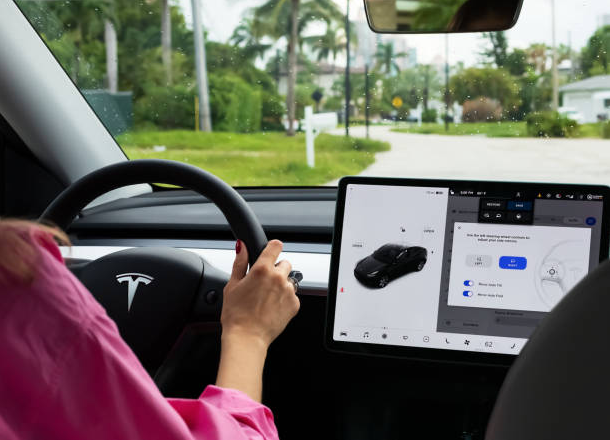Tesla recommends a tire pressure of between 40 and 45 psi for both the front and rear tires of the Model Y compact SUV. However, the model and vehicle configuration will ultimately determine the maximum load.
If you use the Tesla Model Y, it is recommended that you keep your tires inflated to the pressures specified on the tire information label, even if they differ from the pressure printed on the tire’s sidewall.
You can find the tire information label on the center door pillar of your vehicle, which is visible when you open the driver door, as illustrated in the image below:
According to Tesla, your tires will lose one PSI for every 6° drop in the outside temperature. As a result, it is critical to keep the tires properly inflated, especially in cold weather. The TPMS indicator light will come on in such conditions, prompting you to inflate the tires properly before driving.
In the rest of this post, we will review the different recommended tire pressures for the mid-size SV concerning their model year, trim, and OEM tire size.
Table of Contents
Tesla Tire Pressure Model Y and Tire Size (Table)
| Recommended Tire pressure | |||
| Subaru Impreza Year Model | Tire Size | Front tire | Rear tire |
| 2022 | 233/35/ZR21Y98 | 35 psi | 35 psi |
| 2021 | F: 255/35R21/XL 98W R: 275/35R21/XL 103W | 42 psi | 42 psi |
| 255/40R20/XL 101W | |||
| 255/45R19/XL 104W | |||
| 2020 | F: 255/35R21/XL 98(Y) R: 275/35R21/XL 103(Y) | 42 psi | 42 psi |
| 255/40R20/XL 101W | |||
| 255/45R19/XL 104W | |||
| Long Range | 255/40R20 101W XL | 42 psi | 42 psi |
| 255/45R19 104W XL | |||
| Performance | F: 255/35R21 98(Y) XL R: 275/35R21 103(Y) XL | 42 psi | 42 psi |
What is the Tesla model y tire pressure warning?
The Tesla Model Y has a tag on the driver’s side door that suggests what tire pressure you should work with. The tire pressure warning is indicated through the pressure checking system when there is underinflation or overinflation of the tires.
This ignition will not go off until the issue with tire pressure is resolved.
Does Tesla Model Y have a tire pressure monitoring system?
Yes, the pressure of your tires in the Tesla Model Y is displayed on the touchscreen in the cards on the car status display.
You can also find out the tire pressure of all four tires by navigating to Controls > Service. The display also shows you the last time the tire pressures were measured.
On the touchscreen, you can determine whether the tire pressure should be displayed in bars or PSI. To do this, navigate to Controls > Display > Tire Pressure.
The best part is that the touchscreen on your Tesla model will also display the recommended cold tire pressure for your vehicle, which gives you an idea of how much to inflate your tires for optimal performance.
Meanwhile, the tire pressure values on the Tesla Model Y may not change until you drive briefly.
How do I reset the Tesla Model Y TPMS light?
After correctly re-filling your tires, the TPMS light may remain. You must reset the monitoring system to get accurate readings to turn this light off. Here’s how to do it:
Step 1: Go to Settings on your model y touch screen
Step 2: Click on Services & Reset
Step 3: Tap on the Tire Pressure Monitor and click Reset Sensors.
Step 4: Touch the Reset button
Step 5: Tap OK, and press and hold one of the scroll wheels.
Step 6: Click on “car status” and then observe the tire pressure information of your Model Y.
After taking these steps, drive the vehicle at 25 mph for 15 to 20 minutes to allow the auto-learning process to begin.
Afterward, the TPMS glitch should have cleared, and you will now see the accurate readings of your present tire pressures.
If the warning light remains, there is more than meets the eye. You can repeat the steps. If nothing changes, then I recommend you contact your dealership.
Before you go
According to Tesla, most reported tire failures of the Model Y stem from underinflation, leading to tire overheating, tread separation, and even a blowout.
Now that you know the recommended tire pressure for your model y, it is best to keep your tires inflated to such levels for the best performance. But it doesn’t end there.
It would be best if you took some measures while driving your Tesla, even after setting the right tire pressure.
For example, I recommend always carrying a portable compressor with you in case of an emergency or a TPMS ignition warning. Also, if you notice the vehicle is heating up as you drive, you should stop and inspect the tires.
Finally, it’s ideal for checking the tire pressure of all four wheels every week, especially if you don’t drive it regularly, as temperature changes could cause a loss of pressure over time.
Speaking of temperature changes, cold tires tend to lose their PSI, and you should look out for flat spots during these periods.
I hope you found this helpful.

